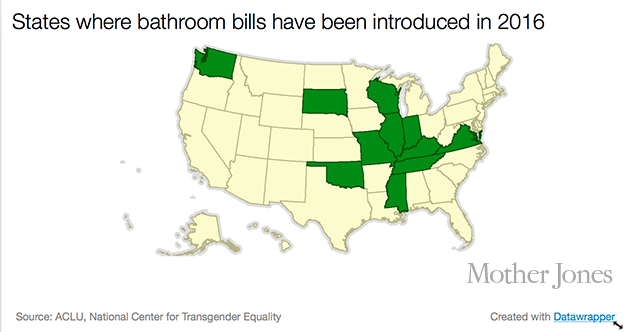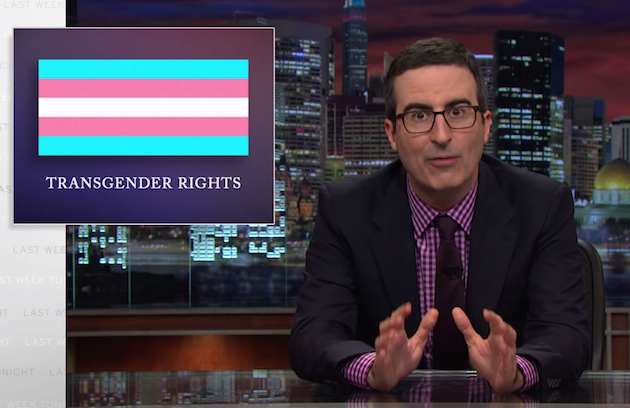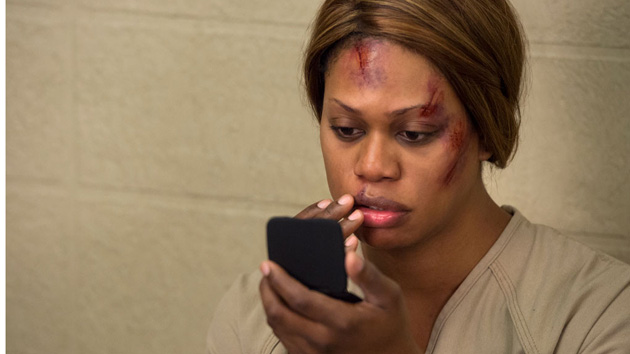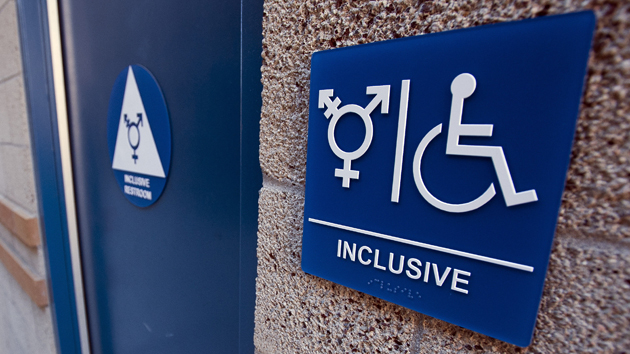
Update (3/1/2016): South Dakota’s Republican Gov. Dennis Daugaard vetoed a bill on Tuesday that would have required transgender students to use school bathrooms and locker rooms corresponding with their birth sex, rather than their gender identities. South Dakota would have been the first state to approve this type of legislation. Daugaard said he rejected the bill because it did “not address any pressing issue” and because he believed questions of bathroom use would be better left to local school officials.
When Thomas Lewis, 18, came out as transgender at his South Dakota high school last March, the simple act of going to the bathroom became a lot more complicated. His counselor advised him to hold off on switching to the boy’s bathroom right away; he was newly transitioning and still appeared somewhat feminine. “I didn’t want it to be awkward for anyone,” Lewis says. But he didn’t want to continue to use the girl’s room, either—the thought of it made him panicky. So he’d stop home at lunch to relieve himself and then return to class. These days, he still often goes home out of habit, “but I can also use the men’s room at my school, and I do.”
Though maybe not for long. South Dakota is one signature away from becoming the first state in the country to prohibit transgender students from using school bathrooms and locker rooms corresponding with their gender identities. Gov. Dennis Daugaard has until March 1 to sign or veto a bill, passed by the state Senate in mid-February, that reserves multiperson bathrooms, locker rooms, and shower rooms in public schools for kids of the same biological sex—as determined by their chromosomes and anatomy at birth.
For transgender students, that means either going to a bathroom where they feel out of place or opting instead to use a unisex or single-person bathroom—an option that some say unfairly singles them out as different. “You’re putting more stigma around them, and there’s now more of a chance for them to be ostracized in school because they’re being put into a kind of problem box,” Lewis says.
The bill’s supporters say the measure will protect students’ privacy. But opponents of the bill have argued it violates Title IX, a federal civil rights law that prohibits discrimination on the basis of sex in federally funded education programs. The Obama administration seems to support that interpretation.
Even so, South Dakota isn’t the only state considering a so-called “bathroom bill.” An increasing number of kids are coming out as transgender at earlier ages, and lawmakers in at least 10 other states (highlighted in green in the map above) have introduced similar bills already this year. While they’re not necessarily the first to do so—similar legislation was proposed in several states last year, as my colleagues Julia Lurie and Sam Brodey reported—momentum appears to be growing. “Certainly this legislative session has the most anti-trans bills we’ve seen,” says Chase Strangio, a staff attorney for the American Civil Liberties Union.
Transgender issues have become more visible in the United States over the past year, thanks in part to the high-profile transition of Olympic gold medalist Caitlyn Jenner and transgender characters on screen, like Jeffrey Tambor’s Maura in Transparent. (Jenner has joined transgender actress Laverne Cox in opposing the South Dakota bill on social media.) But “with increased visibility comes increased targeting,” says the ACLU’s Strangio, who adds that the bathroom bills may be part of a conservative backlash to the Supreme Court’s legalization of gay marriage in June 2015.
Tell @SDGovDaugaard to protect trans kids by vetoing #HB1008. https://t.co/aui4kiIcD5
— Caitlyn Jenner (@Caitlyn_Jenner) February 23, 2016
The bills are likely all welcome news for a deep-pocketed conservative group called Alliance Defending Freedom. The Arizona-based group emailed school districts across the country in 2014, urging them to adopt its “Student Physical Privacy Policy,” which states that “student restrooms, locker rooms, and showers that are designated for one sex shall only be used by members of that sex.” With more than 3,000 allied attorneys and $44 million in case funding, the Alliance has offered free legal counsel to school districts that adopt its policy and are sued as a result.
In October last year, the US Justice Department and Education Department came out in support of a Virginia transgender teenager, Gavin Grimm, who is currently suing for access to the boys’ bathrooms at his high school. In friend-of-the-court briefs, both departments argued that the Virginia school’s policy of barring Grimm from these bathrooms denied “a benefit that every other student at this school enjoys: access to restrooms that are consistent with his or her gender identity.”
“Treating a student differently from other students because his birth-assigned sex diverges from his gender identity constitutes differential treatment on the basis of sex under Title IX,” lawyers for the two departments wrote. The lawsuit, which began last June, went in January to a federal appeals court—the first time a federal court has considered whether such restrictions on bathroom usage violate the federal civil rights law.
Even outside the courtroom, restrictive bathroom policies could be costly for schools and put their Title IX funding at risk. And if South Dakota’s bathroom bill becomes law, it’s also unclear how schools there would enforce the rule. It “would require really intrusive examination of students’ identity documents and possibly anatomy,” says Kris Hayashi, executive director of the California-based Transgender Law Center.
Lewis, who’s graduating soon, worries the South Dakota bill, if enacted, will deter other students from openly living as transgender. “There’s definitely a lot of, ‘If I did fully come out, not only might I get a bad reaction from my family, but I can’t use the bathroom where I want to use the bathroom at school,'” he said, urging legislators to have an open mind. “Bathrooms don’t need to change—people do.”













